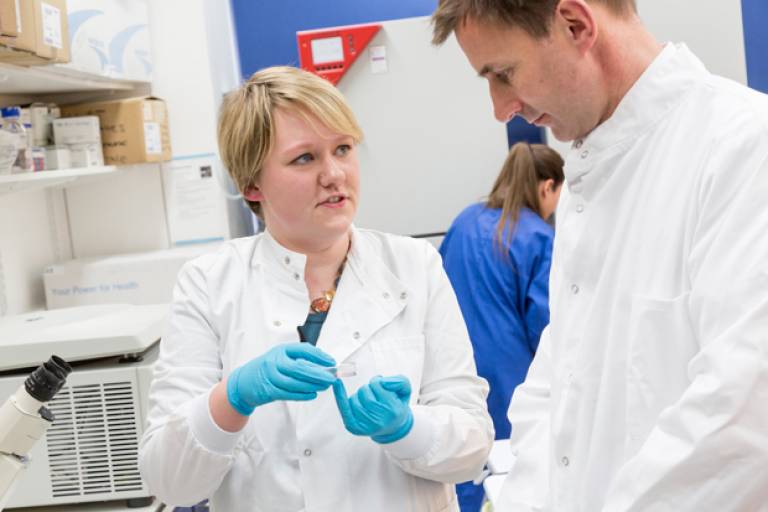Dementia in a dish

1 January 1970
Dr Selina Wray works in the UCL Dementia Research Centre, turning skin cells into brain cells, effectively growing 'dementia in a dish' in an effort to find effective treatment for dementia.
Dr Selina Wray showing Health Secretary Jeremy Hunt around her laboratory
"What we do is look at dementia in a dish," explains Dr Selina Wray. It might sound very strange but that's exactly what her research into brain cells and dementia involves.
"The brain is made up of cells called neurons," she explains. "What happens in dementia is that those neurons progressively die. That's what leads to the symptoms. We want to know what's causes them to die. If we understand that, we can develop ways to stop that happening."
Studying live brain cells, however, is tricky. You can't take brain tissue from a living patient the way you would take a sample of breast tissue or skin tissue to check for cancer, for example. It's a problem that scientists have worked for many years to overcome - and they've come up with an ingenious solution.
"We ask patients with dementia who come into UCL's clinics if they would mind donating a sample of their skin cells," says Wray, who is senior research associate at UCL's Department of Molecular Neuroscience. "It's a little piece of skin from the upper arm, about the size of a rubber on the top of a pencil.
"We then use complex techniques, for which scientists John Gurdon and Shinya Yamanaka won the Nobel Prize in 2012, to change those skin cells to stem cells. A stem cell is like a master cell. If you send it the right signals, you can change it into any cell type you like. So our cells go from skin cells, to stem cells - then, to brain cells, which we grow in a dish.
"We can then look at them under a microscope and compare those brain cells from people who don't have dementia with brain cells from people who do. By having this 'dementia in a dish', we can study exactly what goes on."
These studies include looking at how long cells can survive, adding different substances to the cells to see how they react, or examining the kind of proteins that build up in the brain cells of people with Alzheimer's.
Her dream is ultimately to find a drug, or a combination of drugs, that stops cells from getting sick and dying. If a drug seems to work well on the cells in the dish, her team can then work on getting it tested to see if it's suitable to give to humans in clinical trials.
Wray - who, at just 32, was named Red Magazine's Pioneer of the Year for her work - believes that the new Dementia Research Institute (DRI), partly funded by the money raised by the UCL Dementia Partnership, will make a huge difference to her work.
Not only will it provide more facilities for researchers, it will help gather that expertise all in one place, helping scientists to exchange ideas and enabling researchers like herself to observe patients and get a sense of the challenges they face.
And she's optimistic that effective treatments for dementia will be a reality sooner, rather than later.
"All of us in the field feel like research is really heading in the right direction," she says. "We are all really optimistic that within a decade, we will have treatments come through. Dementia research really needs projects like the DRI, so we can get treatments into clinics and get better and better treatment as time goes on.
"Sir Terry Pratchett, who died last year from posterior cortical atrophy, a rare form of Alzheimer, said that he hoped his generation would be the last to really fear dementia, and I hope that will be the case. The money will be going to good use. We can have hope. We absolutely will get there."
 Close
Close


